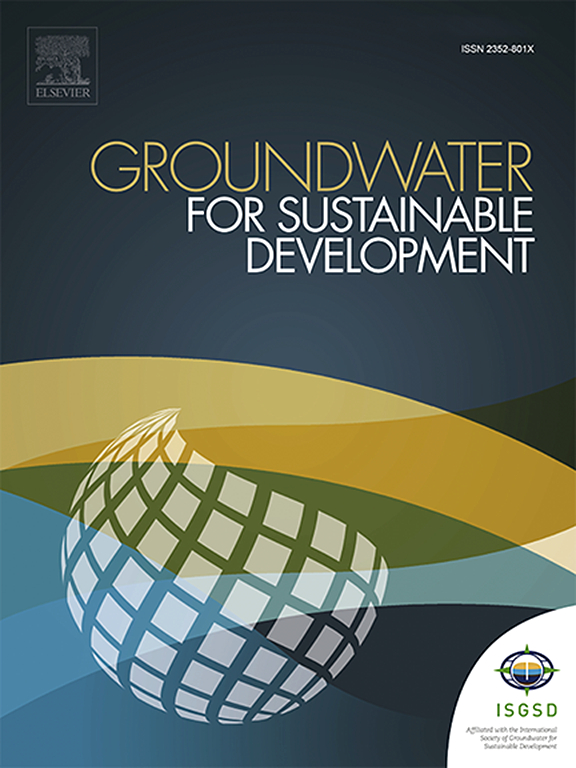评估中部非洲喀麦隆东部地区贝尔图阿市及其周边地区花岗岩-麻质含水层地表水和地下水中潜在有害元素:对人类健康的影响
IF 4.9
Q2 ENGINEERING, ENVIRONMENTAL
引用次数: 0
摘要
这项对喀麦隆东部大区贝尔图阿市及其周边地区(北纬 4.46-4.6° ,东经 13.64-13.8° )的研究旨在评估地表水和地下水源中的潜在有害元素及其潜在的健康风险,同时与可持续发展目标(SDGs)保持一致,尤其是与可持续发展目标 3 "确保健康 "和可持续发展目标 6 "确保清洁水和卫生设施 "保持一致。对 30 份水样进行了主要离子含量分析:在雨季和旱季,使用离子色谱法 (IC) 分析了 Na+、K+、Ca2+、Mg2+、SO42-、HCO3-、N03- 和 Cl-,在旱季使用电感耦合等离子体质谱法 (ICP-MS) 分析了包括 Al、Si、Se、Fe、Cr、Co 和 Cu 在内的 PHEs。结果表明,NO3- 和 Al 含量较高,超过了世界卫生组织规定的允许限值。在地下水中,雨季的 NO3- 浓度介于 0 至 643.5 毫克/升之间,旱季介于 0 至 705.4 毫克/升之间,而 Al 浓度介于 0.02 至 1.79 毫克/升之间:均高于世界卫生组织的限值。在地表水中,NO3-浓度在雨季为 152.71 至 188 毫克/升,旱季为 143.3 至 166.5 毫克/升,而 Al 浓度为 0.004 至 0.12 毫克/升,均高于同一饮用水标准。水的类型为 Na+-K+-SO42-、Ca2+-HCO3-、Ca2+-SO42- 和 Ca2+-Cl-,主要由简单溶解和离子交换作用造成。岩石风化是控制地下水化学的主要水文地质化学过程,大气降水的影响微乎其微。污染源来自人为和地质来源。计算得出的男性、女性和儿童的 NO3-、Al、Se 和 Fe 的 HQoral 值均大于 1(HQoral > 1),其中儿童的 HQoral 值高于其他人口年龄组,这是因为儿童的体型与体积比较大。所有人口年龄组的 HQdermal 值都很低,低于安全限值 1,表明皮肤接触不会对人体健康造成危害。本文章由计算机程序翻译,如有差异,请以英文原文为准。

Assessment of potentially harmful elements in surface and groundwater from the granito-gneissic aquiferous formations in Bertoua city and environs, East Region, Cameroon, Central Africa: Effects on human health
This study of Bertoua city and its environs, in the East Region of Cameroon (4.46–4.6° N, 13.64–13.8° E) was to assess potentially harmful elements in surface and groundwater sources and their potential health risks, aligning with the Sustainable Development Goals (SDGs), particularly SDG 3, ensuring good health and SDG 6, ensuring clean water and sanitation. Thirty water samples were analysed for the presence of major ions: Na+, K+, Ca2+, Mg2+, SO42−, HCO3−, N03-, and Cl− using ion chromatography (IC) during both the wet and dry seasons, and PHEs including Al, Si, Se, Fe, Cr, Co, and Cu using inductive coupled plasma mass spectrometry (ICP-MS) during the dry season. Results indicated high NO3− and Al above the permissible limits set by the World Health Organization. In groundwater, NO3− concentrations ranged from 0 to 643.5 mg/L in the wet season and 0–705.4 mg/L in the dry season, while Al concentrations ranged from 0.02 to 1.79 mg/L: both above the World Health Organization limit. In surface water, NO3− concentrations ranged from 152.71 to 188 mg/L in the wet season and 143.3–166.5 mg/L in the dry season, while Al concentrations ranged from 0.004 to 0.12 mg/L both above the same drinking water standard. The water types were Na+-K+-SO42-, Ca2+-HCO3-, Ca2+-SO42- and Ca2+-Cl-, with simple dissolution and ion exchange responsible for them. Rock weathering was the dominant hydrogeochemical process controlling groundwater chemistry with minimal influence from atmospheric precipitation. Contamination inputs were from anthropogenic and geogenic sources. Calculated HQoral for males, females and children were greater than one (HQoral > 1) for NO3−, Al, Se, and Fe with children having higher values compared to the other demographic age groups due to a larger body-size-to-volume ratio. The HQdermal values were low and below the safe limit of 1 for all demographic groups, indicating no health risks to the population from dermal exposure.
求助全文
通过发布文献求助,成功后即可免费获取论文全文。
去求助
来源期刊

Groundwater for Sustainable Development
Social Sciences-Geography, Planning and Development
CiteScore
11.50
自引率
10.20%
发文量
152
期刊介绍:
Groundwater for Sustainable Development is directed to different stakeholders and professionals, including government and non-governmental organizations, international funding agencies, universities, public water institutions, public health and other public/private sector professionals, and other relevant institutions. It is aimed at professionals, academics and students in the fields of disciplines such as: groundwater and its connection to surface hydrology and environment, soil sciences, engineering, ecology, microbiology, atmospheric sciences, analytical chemistry, hydro-engineering, water technology, environmental ethics, economics, public health, policy, as well as social sciences, legal disciplines, or any other area connected with water issues. The objectives of this journal are to facilitate: • The improvement of effective and sustainable management of water resources across the globe. • The improvement of human access to groundwater resources in adequate quantity and good quality. • The meeting of the increasing demand for drinking and irrigation water needed for food security to contribute to a social and economically sound human development. • The creation of a global inter- and multidisciplinary platform and forum to improve our understanding of groundwater resources and to advocate their effective and sustainable management and protection against contamination. • Interdisciplinary information exchange and to stimulate scientific research in the fields of groundwater related sciences and social and health sciences required to achieve the United Nations Millennium Development Goals for sustainable development.
 求助内容:
求助内容: 应助结果提醒方式:
应助结果提醒方式:


